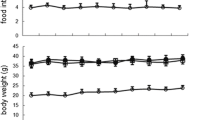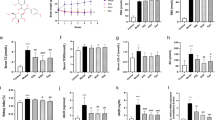Abstract
Background
Recent years of evidence suggest the crucial role of renal tubular cells in developing diabetic kidney disease. Scopoletin (SCOP) is a plant-based coumarin with numerous biological activities. This study aimed to determine the effect of SCOP on renal tubular cells in developing diabetic kidney disease and to elucidate mechanisms.
Methods and results
In this study, SCOP was evaluated in vitro using renal proximal tubular (HK-2) cells under hyperglycemic conditions to understand its mechanism of action. In HK-2 cells, SCOP alleviated the high glucose-generated reactive oxygen species (ROS), restored the levels of reduced glutathione, and decreased lipid peroxidation. High glucose-induced alteration in the mitochondrial membrane potential was markedly restored in the SCOP-treated cells. Moreover, SCOP significantly reduced the high glucose-induced apoptotic cell population in the Annexin V-FITC flow cytometry study. Furthermore, high glucose markedly elevated the mRNA expression of fibrotic and extracellular matrix (ECM) components, namely, transforming growth factor (TGF)-β, alfa-smooth muscle actin (α-SMA), collagen I, and collagen III, in HK-2 cells compared to the untreated cells. SCOP treatment reduced these mRNA expressions compared to the high glucose-treated cells. Collagen I and TGF-β protein levels were also significantly reduced in the SCOP-treated cells. Further findings in HK-2 cells revealed that SCOP interfered with the epithelial-mesenchymal transition (EMT) in the high glucose-treated HK-2 cells by normalizing E-cadherin and downregulating the vimentin and α-SMA proteins.
Conclusions
In conclusion, SCOP modulates the high glucose-generated renal tubular cell oxidative damage and accumulation of ECM components and may be a promising molecule against diabetic nephropathy.






Similar content being viewed by others
Data availability
The data will be made available from the corresponding author on reasonable request.
References
Rayego-Mateos S, Morgado-Pascual JL, Opazo-Ríos L, Guerrero-Hue M, García-Caballero C, Vázquez-Carballo C, Mas S, Sanz AB, Herencia C, Mezzano S (2020) Pathogenic pathways and therapeutic approaches targeting inflammation in diabetic nephropathy. Int J Mol Sci 21(11):3798. https://doi.org/10.3390/ijms21113798
Thomas HY, Ford Versypt AN (2022) Pathophysiology of mesangial expansion in diabetic nephropathy: mesangial structure, glomerular biomechanics, and biochemical signaling and regulation. J Biol Eng 16(1):19. https://doi.org/10.1186/s13036-022-00299-4
Zhang H, Colclough K, Gloyn AL, Pollin TI (2021) Monogenic diabetes: a gateway to precision medicine in diabetes. J Clin Invest 131(3):e142244. https://doi.org/10.1172/JCI142244
Tang Y, Shah H, Bueno Junior CR, Sun X, Mitri J, Sambataro M, Sambado L, Gerstein HC, Fonseca V, Doria A (2021) Intensive risk factor management and cardiovascular autonomic neuropathy in type 2 diabetes: the ACCORD trial. Diabetes Care 44(1):164–173. https://doi.org/10.2337/dc20-1842
Gilbert RE (2017) Proximal tubulopathy: prime mover and key therapeutic target in diabetic kidney disease. Diabetes 66(4):791–800. https://doi.org/10.2337/db16-0796
Hasegawa K, Wakino S, Simic P, Sakamaki Y, Minakuchi H, Fujimura K, Hosoya K, Komatsu M, Kaneko Y, Kanda T (2013) Renal tubular Sirt1 attenuates diabetic albuminuria by epigenetically suppressing Claudin-1 overexpression in podocytes. Nat Med 19(11):1496–1504. https://doi.org/10.1038/nm.3363
Skorecki K, Chertow GM, Marsden PA, Taal MW, Alan S, Luyckx V (2016) Brenner & rector’s the kidney. Elsevier, Hoboken
Vallon V (2011) The proximal tubule in the pathophysiology of the diabetic kidney, american journal of physiology-regulatory. Am J Physiol Regul Integr Comp Physiol 300(5):R1009–R1022. https://doi.org/10.1152/ajpregu.00809.2010
Lee YJ, Han HJ (2010) Troglitazone ameliorates high glucose-induced EMT and dysfunction of SGLTs through PI3K/Akt, GSK-3β, Snail1, and β-catenin in renal proximal tubule cells. Am J Physiol Renal Physiol 298(5):F1263–F1275. https://doi.org/10.1152/ajprenal.00475.2009
Slyne J, Slattery C, McMorrow T, Ryan MP (2015) New developments concerning the proximal tubule in diabetic nephropathy: in vitro models and mechanisms. Nephrol Dial Transplant. https://doi.org/10.1093/ndt/gfv264
Bakin AV, Tomlinson AK, Bhowmick NA, Moses HL, Arteaga CL (2000) Phosphatidylinositol 3-kinase function is required for transforming growth factor β-mediated epithelial to mesenchymal transition and cell migration. J Biol Chem 275(47):36803–36810. https://doi.org/10.1074/jbc.M005912200
Jang JH, Park JE, Han JS (2018) Scopoletin inhibits α-glucosidase in vitro and alleviates postprandial hyperglycemia in mice with diabetes. Eur J Pharmacol 834:152–156. https://doi.org/10.1016/j.ejphar.2018.07.032
Panda S, Kar A (2006) Evaluation of the antithyroid, antioxidative and antihyperglycemic activity of scopoletin from Aegle marmelos leaves in hyperthyroid rats. Phytother Res 20(12):1103–1105. https://doi.org/10.1002/ptr.2014
Jang JH, Park JE, Han JS (2020) Scopoletin increases glucose uptake through activation of PI3K and AMPK signaling pathway and improves insulin sensitivity in 3T3-L1 cells. Nutr Res 74:52–61. https://doi.org/10.1016/j.nutres.2019.12.003
Liang Y, Zeng X, Guo J, Liu H, He B, Lai R, Zhu Q, Zheng Z (2021) Scopoletin and umbelliferone from cortex mori as protective agents in high glucose-induced mesangial cell as in vitro model of diabetic glomerulosclerosis. Chin J Physiol 64(3):150–158. https://doi.org/10.4103/cjp.cjp_9_21
Kundu S, Ghosh A, Yadav KS, Mugale MN, Sahu BD (2023) Imperatorin ameliorates kidney injury in diabetic mice by regulating the TGF-β/Smad2/3 signaling axis, epithelial-to-mesenchymal transition, and renal inflammation. Eur J Pharmacol 963:176250. https://doi.org/10.1016/j.ejphar.2023.176250
Park JE, Han JS (2023) Scopoletin protects INS-1 pancreatic β cells from glucotoxicity by reducing oxidative stress and apoptosis. Toxicol In Vitro 93:105665. https://doi.org/10.1016/j.tiv.2023.105665
Syed AM, Kundu S, Ram C, Kulhari U, Kumar A, Mugale MN, Murty US, Sahu BD (2022) Aloin alleviates pathological cardiac hypertrophy via modulation of the oxidative and fibrotic response. Life Sci 288:120159. https://doi.org/10.1016/j.lfs.2021.120159
Joshi S, Kundu S, Priya VV, Kulhari U, Mugale MN, Sahu BD (2023) Anti-inflammatory activity of carvacrol protects the heart from lipopolysaccharide-induced cardiac dysfunction by inhibiting pyroptosis via NLRP3/Caspase1/Gasdermin D signaling axis. Life Sci 324:121743. https://doi.org/10.1016/j.lfs.2023.121743
Kulhari U, Kundu S, Mugale MN, Sahu BD (2023) Nuciferine alleviates intestinal inflammation by inhibiting MAPK/NF-κB and NLRP3/Caspase 1 pathways in vivo and in vitro. Int Immunopharmacol 115:109613. https://doi.org/10.1016/j.intimp.2022.109613
Zhao G, Teng J, Dong R, Ban Q, Yang L, Du K, Wang Y, Pu H, Yang CS, Ren Z (2023) Alleviating effects and mechanisms of action of large-leaf yellow tea drinking on diabetes and diabetic nephropathy in mice. Food Sci Hum Wellness 12(5):1660–1673. https://doi.org/10.1016/j.fshw.2023.02.023
Wei Y, Hu L, Liu G (2023) Therapeutic improvements of nifedipine controlled-release tablets combined with sacubitril valsartan on patients with diabetic nephropathy complicated with hypertension. Int Immunopharmacol 123:110755. https://doi.org/10.1016/j.intimp.2023.110755
Wang T, Zheng L, Liu X, Zhao M (2023) Sea cucumber (Holothuria nobilis) hydrolysates improve diabetic nephropathy via suppression of oxidative stress in high-fat diet/streptozotocin-induced diabetic rats. J Funct Foods 106:105589. https://doi.org/10.1016/j.jff.2023.105589
He B-T, Liu Z-H, Li B-Z, Yuan Y-J (2022) Advances in biosynthesis of scopoletin. Microb Cell Fact 21(1):1–9. https://doi.org/10.1186/s12934-022-01865-7
Parama D, Girisa S, Khatoon E, Kumar A, Alqahtani MS, Abbas M, Sethi G, Kunnumakkara AB (2022) An overview of the pharmacological activities of scopoletin against different chronic diseases. Pharmacol Res 179:106202. https://doi.org/10.1016/j.phrs.2022.106202
Czajka A, Malik AN (2016) Hyperglycemia induced damage to mitochondrial respiration in renal mesangial and tubular cells: Implications for diabetic nephropathy. Redox Biol 10:100–107. https://doi.org/10.1016/j.redox.2016.09.007
Wang J, Guo HM (2019) Astragaloside IV ameliorates high glucose-induced HK-2 cell apoptosis and oxidative stress by regulating the Nrf2/ARE signaling pathway. Exp Ther Med 17(6):4409–4416. https://doi.org/10.3892/etm.2019.7495
Guo C, Sun L, Chen X, Zhang D (2013) Oxidative stress, mitochondrial damage and neurodegenerative diseases. Neural Regen Res 8(21):2003. https://doi.org/10.3969/j.issn.1673-5374.2013.21.009
Zhang X-Q, Dong J-J, Cai T, Shen X, Zhou X-J, Liao L (2017) High glucose induces apoptosis via upregulation of Bim expression in proximal tubule epithelial cells. Oncotarget 8(15):24119. https://doi.org/10.18632/oncotarget.15491
Sharma D, Gondaliya P, Tiwari V, Kalia K (2019) Kaempferol attenuates diabetic nephropathy by inhibiting RhoA/Rho-kinase mediated inflammatory signalling. Biomed Pharmacother 109:1610–1619. https://doi.org/10.1016/j.biopha.2018.10.195
Chen D-Q, Guo Y, Guo Z-Y, Tang Y-P (2022) New insights into renal fibrosis and therapeutic effects of natural products volume II. Front Pharmacol 13:1053408. https://doi.org/10.3389/fphar.2022.1053408
Wang L, Wang H-L, Liu T-T, Lan H-Y (2021) TGF-beta as a master regulator of diabetic nephropathy. Int J Mol Sci 22(15):7881. https://doi.org/10.3390/ijms22157881
Hong-Bo W, Wen-Ke H, Xiong Y-W, Zhou-Hui J, Zhen L, Cheng L, Zhang X-M, Wen P (2018) Taxus chinensis ameliorates diabetic nephropathy through down-regulating TGF-β1/Smad pathway. Chin J Nat Med 16(2):90–96. https://doi.org/10.1016/S1875-5364(18)30034-7
Ziyadeh FN, Snipes ER, Watanabe M, Alvarez RJ, Goldfarb S, Haverty TP (1990) High glucose induces cell hypertrophy and stimulates collagen gene transcription in proximal tubule. Am J Physiol 259(4):F704–F714. https://doi.org/10.1152/ajprenal.1990.259.4.F704
Szeto SG, Narimatsu M, Lu M, He X, Sidiqi AM, Tolosa MF, Chan L, De Freitas K, Bialik JF, Majumder S (2016) YAP/TAZ are mechanoregulators of TGF-β-Smad signaling and renal fibrogenesis. J Am Soc Nephrol 27(10):3117. https://doi.org/10.1681/ASN.2015050499
Forrester SJ, Kawai T, O’Brien S, Thomas W, Harris RC, Eguchi S (2016) Epidermal growth factor receptor transactivation: mechanisms, pathophysiology, and potential therapies in the cardiovascular system. Annu Rev Pharmacol Toxicol 56:627–653. https://doi.org/10.1146/annurev-pharmtox-070115-095427
Li Y, Hu Q, Li C, Liang K, Xiang Y, Hsiao H, Nguyen TK, Park PK, Egranov SD, Ambati CR (2019) PTEN-induced partial epithelial-mesenchymal transition drives diabetic kidney disease. J Clin Invest 129(3):1129–1151. https://doi.org/10.1172/JCI121987
Yuan Q, Tan RJ, Liu Y (2019) Myofibroblast in kidney fibrosis: origin, activation, and regulation. Adv Exp Med Biol 1165:253–283. https://doi.org/10.1007/978-981-13-8871-2_12
Scanlon C, Van Tubergen E, Inglehart R, D’silva N (2013) Biomarkers of epithelial-mesenchymal transition in squamous cell carcinoma. J Dent Res 92(2):114–121. https://doi.org/10.1177/0022034512467352
Funding
This study was supported by the Indian Council of Medical Research (ICMR) (Grant No. 5/7/1762/CH/Adhoc/RBMCH-2021), Ministry of Health and Family Welfare, Government of India and the Department of Pharmaceuticals, Ministry of Chemicals and Fertilizers, Government of India.
Author information
Authors and Affiliations
Contributions
Sourav Kundu and Sitara Ghosh: Performed all experiments and methodology, prepared figures, and wrote the main manuscript. Bidya Dhar Sahu: Supervision, Funding acquisition, resources, Edited final manuscript.
Corresponding author
Ethics declarations
Competing interest
All authors declare that they have no conflicts of interest.
Ethical approval
Not applicable.This research did not involve human or animal subjects.
Additional information
Publisher's Note
Springer Nature remains neutral with regard to jurisdictional claims in published maps and institutional affiliations.
Supplementary Information
Below is the link to the electronic supplementary material.
Rights and permissions
Springer Nature or its licensor (e.g. a society or other partner) holds exclusive rights to this article under a publishing agreement with the author(s) or other rightsholder(s); author self-archiving of the accepted manuscript version of this article is solely governed by the terms of such publishing agreement and applicable law.
About this article
Cite this article
Kundu, S., Ghosh, S. & Sahu, B.D. Scopoletin alleviates high glucose-induced toxicity in human renal proximal tubular cells via inhibition of oxidative damage, epithelial-mesenchymal transition, and fibrogenesis. Mol Biol Rep 51, 620 (2024). https://doi.org/10.1007/s11033-024-09579-2
Received:
Accepted:
Published:
DOI: https://doi.org/10.1007/s11033-024-09579-2




